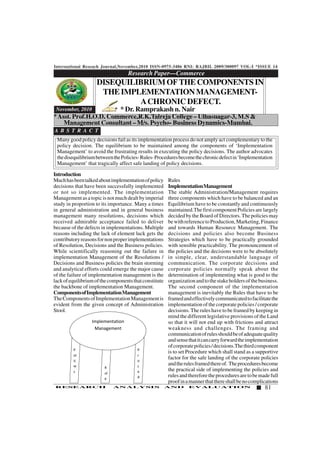
81 82
- 1. International Reseach Journal,November,2010 ISSN-0975-3486 RNI: RAJBIL 2009/300097 VOL-I *ISSUE 14 81RESEARCH ANALYSIS AND EVALUATION Research Paper—Commerce 1234567890123456789012345678901212345678901234567890123456789012123456789012345678901234567890121234567890123456789012345678 1234567890123456789012345678901212345678901234567890123456789012123456789012345678901234567890121234567890123456789012345678 1234567890123456789012345678901212345678901234567890123456789012123456789012345678901234567890121234567890123456789012345678 1234567890123456789012345678901212345678901234567890123456789012123456789012345678901234567890121234567890123456789012345678 1234567890123456789012345678901212345678901234567890123456789012123456789012345678901234567890121234567890123456789012345678 1234567890123456789012345678901212345678901234567890123456789012123456789012345678901234567890121234567890123456789012345678 1234567890123456789012345678901212345678901234567890123456789012123456789012345678901234567890121234567890123456789012345678 1234567890123456789012345678901212345678901234567890123456789012123456789012345678901234567890121234567890123456789012345678 1234567890123456789012345678901212345678901234567890123456789012123456789012345678901234567890121234567890123456789012345678 November, 2010 Introduction Muchhasbeentalkedaboutimplementationofpolicy decisions that have been successfully implemented or not so implemented. The implementation Managementasatopicisnotmuchdealtbyimperial study in proportion to its importance. Many a times in general administration and in general business management many resolutions, decisions which received admirable acceptance failed to deliver because of the defects in implementations. Multiple reasons including the lack of element luck gets the contributoryreasonsfornonproperimplementations of Resolution, Decisions and the Business policies. While scientifically reasoning out the failure in implementation Management of the Resolutions / Decisions and Business policies the brain storming and analytical efforts could emerge the major cause of the failure of implementation management is the lackofequilibriumofthecomponentsthatconstitute the backbone of implementation Management. ComponentsofImplementationManagement TheComponentsofImplementationManagementis evident from the given concept of Administration Stool. DISEQUILIBRIUM OF THE COMPONENTS IN THEIMPLEMENTATION MANAGEMENT- ACHRONIC DEFECT. * Dr. Ramprakash n. Nair A B S T R A C T Many good policy decisions fail as its implementation process do not amply act complementary to the policy decision. The equilibrium to be maintained among the components of ‘Implementation Management’ to avoid the frustrating results in executing the policy decisions. The author advocates thedisequilibriumbetweenthePolicies-Rules-Proceduresbecomethechronicdefectin‘Implementation Management’ that tragically affect safe landing of policy decisions. Rules ImplementationManagement The stable Administration/Management requires three components which have to be balanced and an Equilibrium have to be constantly and continuously maintained.The first component Policies are largely decided by the Board of Directors. The policies may bewithreferencetoProduction,Marketing,Finance and towards Human Resource Management. The decisions and policies also become Business Strategies which have to be practically grounded with sensible practicability. The pronouncement of the policies and the decisions were to be absolutely in simple, clear, understandable language of communication. The corporate decisions and corporate policies normally speak about the determination of implementing what is good to the organizationandtothestakeholdersofthebusiness. The second component of the implementation management is inevitably the Rules that have to be framedandeffectivelycommunicatedtofacilitatethe implementation of the corporate policies / corporate decisions. The rules have to be framed by keeping in mind the different legislative provisions of the Land so that it will not end up with frictions and attract weakness and challenges. The framing and communicationofrulesshouldbeofadequatequality andsensethatitcancarryforwardtheimplementation ofcorporatepolicies/decisions.Thethirdcomponent is to set Procedure which shall stand as a supportive factor for the safe landing of the corporate policies andtherulesframedthereof. Theproceduresbecome the practical side of implementing the policies and rulesandthereforetheproceduresaretobemadefull proofinamannerthatthereshallbenocomplications *Asst. Prof.H.O.D. Commerce,R.K.Talreja College – Ulhasnagar-3, M.S & Management Consultant – M/s. Psycho- Business Dynamics-Mumbai. P ol ic ie s P r o c e d u R ul e s Implementation Management
- 2. International Reseach Journal,November,2010 ISSN-0975-3486 RNI: RAJBIL 2009/300097 VOL-I *ISSUE 14 82 RESEARCH ANALYSIS AND EVALUATION or weakness in the implementation on the decided policies and rules.The three components Policy- Rules- Procedure, shall have to go hand in hand with equal acceptance and importance in the area of ImplementationManagement.Disequilibriuminthese componentscanbedeterenttothesystematicpractice of‘ImplementationManagement’ CaseStudy A Corporate Organisation took a policy decision in its Board Meeting that the employees to be provided with fully paid medical leave. The decision was welcomed by the Managerial as well as non Managerial staff of the Organisation. The policy decision did not get into implementation for almost six months. The frustration mounted among the employees as the policy decision could not be implemented. On review it was found that the implementation Management requires the commitment to the policy decision, framing of rules andprocedureforimplementation.Thepolicydecision was clearly pronounced and the commitment to implement the same was found ample in Place. The rules were framed by the Human Resource Management Department stating the benefit will be madeavailabletotheconfirmedEmployees,Maximum 10 day’s paid Medical leave to be granted in a Year andMedicalCertificateshallberequiredtoavailthe Medical leave. This bunch of rules completed the second stage of ‘implementation Management’ and it was communicated to the Employees. To have the final implementation of the policy the third stage of implementation i.e., the third component i.e., The Procedureplayedavitalrole.Withoutformulationof proceduretoavailthebenefit,thepolicyandtherule shall be dormant. The corporate body set the procedure by introducing the ‘Medical Leave Application Form’ in a proper format that has to be filled by the beneficiary and the format of ‘Medical Certificate’ that to be sought and enclosed with the Application.Therequirementofforwardingtheleave application through proper channel was made the partofproceduralrequirement.Whenthepolicy,rules andprocedureallwerewellsettheimplementationof the corporate policy became smooth and the benefit to the employees became a reality. ReviewandAnalysis Wheneveracorporatepolicydecisionoranywelfare administrative decision fails it essentially indicate disequilibrium that exists in the components of ‘implementation Management’. Many policy decisions remain on paper and many a times the decisions and rules fail to deliver because of the absence of properly formulated procedure to safe land the policies/decisions.The audit of ‘Implementation Management’ should be a special branch of Management in Practice so as to identify and rectify the areas of disequilibrium in implementation of policy decisions. This can have way to having corrective steps before it is too late. Conclusion The disequilibrium of the components in implementationManagementhasbecomeaChronic Defect in realizing what is decided. This inducts confusion and discomfort in General administration andManagement.TheChronicDefectshouldreceive urgent attention that can bring equilibrium among the major components Policies- Rules- Procedure, making them to act complimentary to each other for the comfortability in governance. Anil K Khandelwal, ‘Human Resource Development in Banks’, Oxford and IBH Publishing, New Delhi, 1988. Aswathappa K, ‘Human Resource and Personnel Management’, Tata MacGraw Hill, New Delhi, 1995.Agnihotri V.K., ‘Skills for effective Administrations’, Vikas Publishing House, New Delhi, 1995.Karnik V.G., ‘Personnel Management’, Jaico Publishing, Mumbai, 1984. R E F E R E N C E
